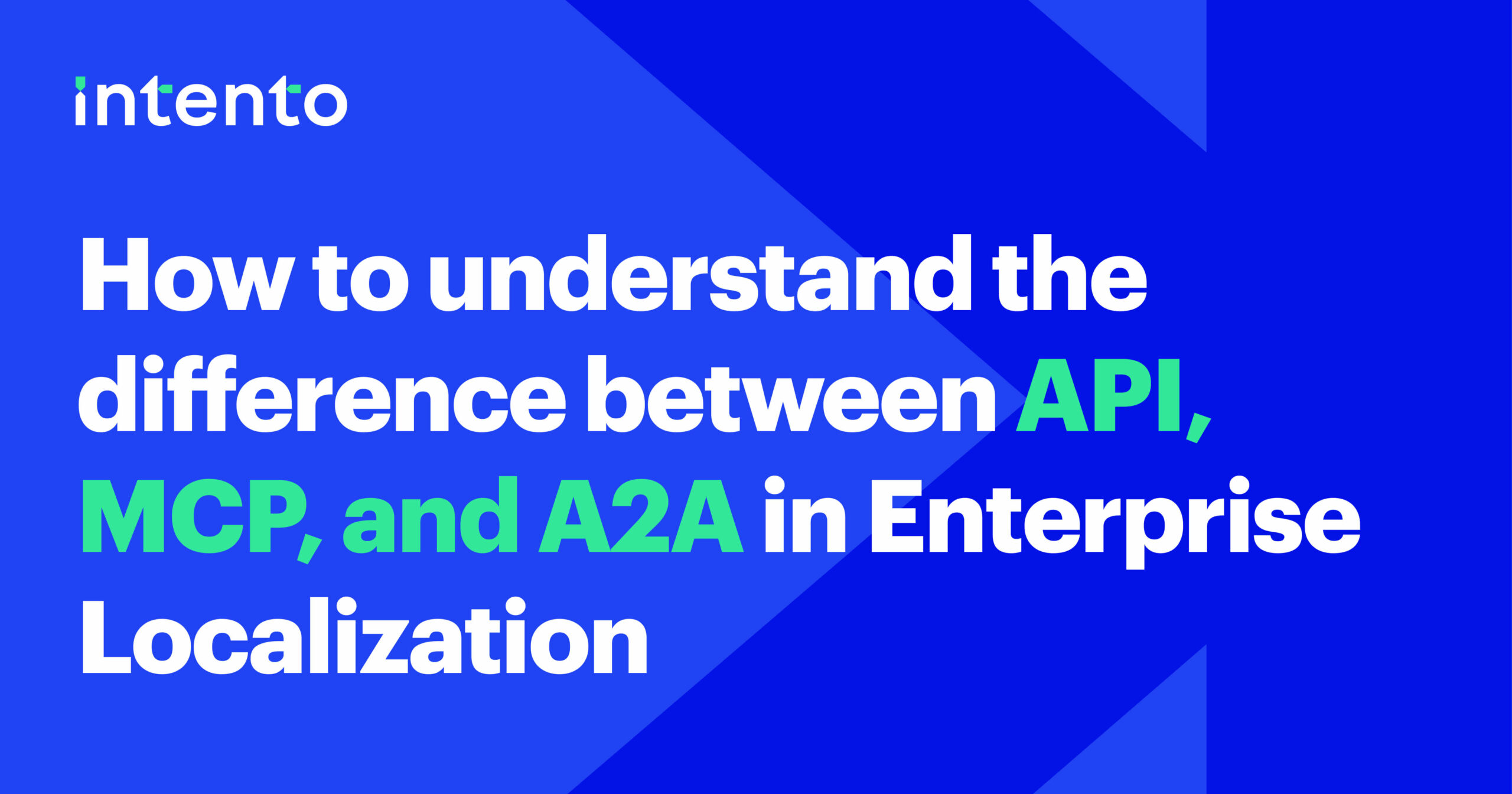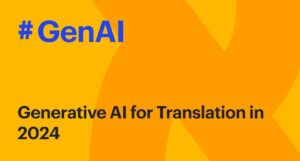Enterprise localization is evolving fast. As AI takes center stage in translation workflows, you’re no longer just dealing with CAT tools, TMSs, and connectors—you have to deal with two more acronyms: MCP and A2A.
This post explains the difference between API, MCP (Model Context Protocol), and A2A (Agent-to-Agent Protocol)—and how each fits into the future of AI-powered localization. If you’re building, managing, or integrating language technology at scale, this is your guide to understanding specific MCP and A2A use cases that can elevate the strategic role of the localization team within your enterprise.
If you prefer video content, you can watch the video.
What is an API, and how is it used in localization?
An API (Application Programming Interface) lets one software system interact with another. In localization, it’s the plumbing that connects your:
- CMS (content management system)
- TMS (translation management system)
- MT engine (machine translation)
Example: When new content is created in your CMS:
- A connector detects the content.
- It calls the TMS API to create a translation project.
- Once translation is done, it pushes localized content back to the CMS.
This process is:
- Deterministic (you know exactly what happens)
- Parameter-driven (you define the languages, content, and service)
- Reliable (assuming no API errors)
APIs are great when you control the workflow and need predictable automation.
Can I use an API to call an AI model?
Yes—and that’s how it works today.
Even when calling AI models (like GPT or a machine translation engine), your TMS or connector uses an API. You send:
- The text
- Source and target language
- Model parameters
And you get a result. That’s it.
So even if the backend is powered by complex GPUs and LLMs, the interaction is still just an API call. You tell the AI what to do, and it does it. No decision-making. No context beyond what you send.
So what’s the problem with just using APIs?
APIs are rigid. If your AI agent needs to:
- Use multiple tools
- Understand internal business context
- Adapt to user needs on the fly
…then APIs start to fall short.
You’d have to:
- Manually describe every tool or system
- Organize tool calls and message exchanges with the model
- Encode everything in a giant prompt
- Repeat that description over and over
That’s inefficient, expensive, and brittle.
What is tooling and function calling, and why isn’t it enough?
Before protocols like MCP and A2A, the way LLMs interacted with external systems was through what’s often called function calling or tooling. This approach lets you define a set of tools—basically small functions with parameters—that the LLM can decide to invoke as part of generating a response. OpenAI, Anthropic, Google, and others offer variants of this feature.
Compared to making a raw API call inside your app, function calling is smarter: the model chooses when and how to use each tool, based on natural language context. Instead of you scripting every step, the model makes decisions.
But the problem is: you still have to define all those tools yourself, often inline in the prompt or system message. Each tool must be described in detail—its name, parameters, response format, and purpose—and you need to send that whole description with every prompt. As your toolset grows, this becomes repetitive, fragile, and expensive, especially when different teams or agents want to use the same tools. On top of that, you’ll need to jump in and run the tools whenever the model asks for them, plus handle all the back-and-forth messaging to feed the model with tool responses.
That’s why MCP was introduced—to take the burden of describing tools off the prompt, creating a standardized way for models to request tool usage. While client libraries can make tool descriptions more convenient, and you still need to execute the tools when the model requests them, MCP provides a consistent framework that works across different AI systems.
What is MCP (Model Context Protocol), and why does it matter?
MCP, proposed by Anthropic, is a standard way for LLMs to access external tools, prompts, and data, without needing to hard-code that information into every prompt.
Think of it as a USB-C port for your AI agent: plug in new tools, and the agent immediately knows how to use them.
In localization, MCP helps your AI access:
- Company directories for gender or naming context
- Translation memory or term bases
- Product catalogs and style guides
How it works:
- External systems (like your CMS, HR system, or terminology DB) run an MCP server
- They describe their capabilities using the MCP spec
- You link these servers in your prompt or system configuration
- Your LLM accesses them dynamically as tools
Now, you don’t need to reinvent tool definitions for every AI project. Your agents can share context, reuse connectors, and stay up to date as systems evolve.
We now have the Intento Translation MCP Server available. You can use it in Claude Desktop or any other application that supports MCP.
When is MCP not enough?
MCP assumes tools behave like APIs: you give input, you get output.
But what if:
- You’re not sure what tool to use?
- The tool is actually another AI agent with logic and policies?
- The task requires multiple steps, decisions, and negotiations?
- You need to route all company translation requests from employees using, for example, ChatGPT or Claude to your specialized translation agent that enforces terminology and style guidelines?
That’s when MCP breaks down. It wasn’t built for dynamic, collaborative, or uncertain workflows.
What is A2A (Agent-to-Agent Protocol), and how is it different?
A2A, proposed by Google, is a protocol for AI agents to discover, communicate, and collaborate with one another—just like humans do.
It enables:
- Multi-step, evolving workflows
- Agent capability discovery via Agent Cards (in JSON)
- Task lifecycle management, status updates, and feedback loops
Example in localization:
Let’s say your AI system needs to localize a product announcement. The workflow might look like this:
-
- A marketing AI agent creates initial content.
- A transcreation agent adapts it to the cultural tone.
- A legal review agent evaluates compliance and may request changes.
- A regional QA agent verifies local norms in Korean (which may not even be documented in English).
- A marketing AI agent creates initial content.
Each agent:
- Has its own policies and data access rights.
- May iterate, delay, or reject steps.
- Needs to talk to others in context.
That’s what A2A makes possible.
So, how do API, MCP, and A2A work together?
Each layer builds on the previous:
| Layer | Purpose | Best Use |
| API | Basic software-to-software communication | Integrating CMS/TMS/MT |
| MCP | Structured tool access for AI | Giving LLMs access to business context |
| A2A | Multi-agent coordination | Orchestrating complex, non-linear workflows |
They’re not replacements for each other. They’re building blocks.
How do I choose between them in localization workflows?
Use an API when:
- You know exactly what service to call and when
- You’re building a connector between existing systems
Use MCP when:
- You want AI to access structured tools like termbases or TM
- You need scalable, reusable access to business context
Use A2A when:
- Multiple AI agents need to coordinate across departments
- You’re building workflows with policies, iterations, and exceptions
All major players now admit that while they may deploy centralized LLMs, each business function needs dedicated AI agents that embed and scale their expertise. These agentic interoperability tools create opportunities for Translation AI Agents to serve every department, from customer support to legal, providing consistent, policy-compliant translations throughout the organization.
What are the key differences between MCP and A2A for Localization
| Feature | MCP (Model Context Protocol) | A2A (Agent-to-Agent Protocol) |
| Purpose | Structured access to external tools and data | Dynamic coordination between intelligent agents |
| Initiator | LLM calls a tool | AI agent interacts with another agent |
| Workflow | Deterministic, API-like | Non-deterministic, iterative |
| Best For | Accessing translation memory, terminology, style guides | Orchestrating multi-agent workflows like marketing → legal → regional QA |
| Who Defines Interface | Tool vendor via MCP server | Each agent via an Agent Card |
| Reusability | High, across prompts and agents | High, across multi-agent ecosystems |
Final Thoughts: The Future of Language Automation
As localization grows more AI-native, we’ll stop thinking in terms of “translation APIs” and start thinking in terms of AI agents equipped with tools that understand, collaborate, and decide.
- APIs help them talk.
- MCP gives them the context.
- A2A lets them work together.
You’ll need all three.



